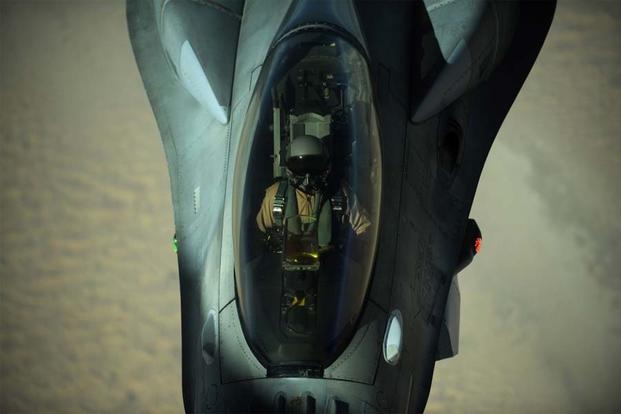The goal is to walk into a room filled with pilots, mission planners, ground controllers and communications specialists from multiple nations and produce a war plan in less than 24 hours.
And, despite unknown requests or impositions that might be thrown in, the mission is still a go the next day.
Now more than ever, the U.S. relies on partner nations to coordinate on high-end fights. In the Middle East, that means bringing together more fighter jets, drones and the people who get them airborne.
The latest biannual Advanced Tactical Leadership Course, coordinated by the Air Warfare Center at Al Dhafra Air Base, United Arab Emirates, wrapped up last month. The course began in 2004.
"Our big mission here is to host big exercises for the region," to include interoperability, tactical capability, and air operations, which includes missile defense with Middle Eastern partners, the Gulf Cooperation Council, and other coalition warfighters "that we're fighting currently with" side-by-side, said Air Force Col. Steven Boatright, commander of the Air Warfare Center.
The region's seven-week version of the service's "Red Flag" exercise starts out with participants hitting the books and mission plans, then training regional partners to behave as mission commanders.
"It gives them the ability to lead many, many airplanes into combat … we're building those guys to be able to handle that type of scenario," Boatright explained, referencing the ongoing air campaigns against the Islamic State of Iraq and Syria.
Training Partners
"We train [partners] in anything from air-to-air, to air-to-surface, to tactics, and even combat search and rescue … or close-air support missions, where we're working with [Joint Terminal Attack Controllers] on the ground" replicating precision-guided weapons launches, he recently told Military.com.
The U.S., Saudi Arabia, UAE, Australia, France, Egypt and Morocco participated in the latest Advanced Tactical Leadership Course. Aircraft included U.S. F-15E Strike Eagles; Royal Australian Air Force E-7A Wedgetails, which are capable of airborne early warning and control; Saudi F-15s and tankers; F-16s from Egypt and Morocco; French Rafale jets; and Emirati Mirage fourth-generation fighters and F-16s.
After Operation Inherent Resolve began in 2014, officials recognized the need and importance of using fifth-generation aircraft in the course. Air Force Chief of Staff Gen. Mark Welsh "personally approved F-22 Raptors" to participate in the course in recent time, "despite the high demand for sorties supporting OIR," according to an Air Force release published last year.
Getting in more fifth-gen assets, "especially as coalition partners start buying the F-35 [Joint Strike Fighter]," and drones is a must, Boatright said, citing that UAE may acquire Predators from the U.S. "sometime next year."
However, UAE has yet to receive General Atomics' unarmed XP models, pending approval through a direct sale deal announced in 2013.
The idea is to "dial up the threat level to make it harder and harder as each day goes by," Boatright said.
Under the Integrated Air and Missile Defense Center, the warfare center separately hosts a three-week missile defense exercise every year similar to that of the Advanced Tactical Leadership Course -- integrating, coordinating and executing with partners in the Gulf Cooperation Council. About 50 leaders and students simulate tracking the distances within the Arabian Gulf region because "the defense of this region is crucial," Boatright said.
"If a conflict ever kicked off, how would we handle it? We spend time talking basics … Hawk, Patriot and short-range defense [missiles] and then we'll talk [Terminal High Altitude Area Defense] and some higher-tier capabilities" before demonstrating a synchronized defensive blueprint, he said.
"My vision in the long term is to do both of these, the flying piece, and a simulated missile defense piece at the same time" for a live-meets-virtual element, Boatright said.
Focused on Air Training
Unlike Red Flag, which has grown to incorporate cyber elements to withstand electronic threats, the Advanced Tactical Leadership Course focuses "more on the air training, because our goal is to build the capability of our regional partners," Boatright said, adding the partners are not "ready for cyber" just yet.
"As the exercise continues to expand, they will likely work in those capabilities but, right now, it's more focused on the complexities that arise in a congested, high-end type of fight," added Capt. Trisha Guillebeau, spokeswoman for Air Forces Central Command.
For example, right now "Saudi Arabia and United Arab Emirates are fighting in Yemen, and the missions we talk about here [are] directly transferrable -- the issues of civilian casualties," Boatright said.
During every mission set in the course, members work hard to make sure civilian casualties are an avoidable risk, from early stages in planning to direct targeting once up in the air.
"The key takeaway is, [the partners] are doing the fighting … and they've gotten to this point, they're very capable air forces, and these exercises just make them better.
"From an American serviceman's perspective, we're busy enough as it is in Iraq and Syria, and the fact that they're handling that situation is a good thing," Boatright said.
As officials continue to develop critical scenarios, "We continue to expand the spectrum," he said. "This is training that needs to be done. You don't want to get thrown into a real-world scenario where you're trying to plan a 40- or 50-ship mission -- and never have practiced it."
-- Oriana Pawlyk can be reached at oriana.pawlyk@military.com. Follow her on Twitter at @Oriana0214.



























